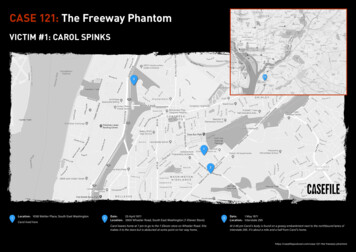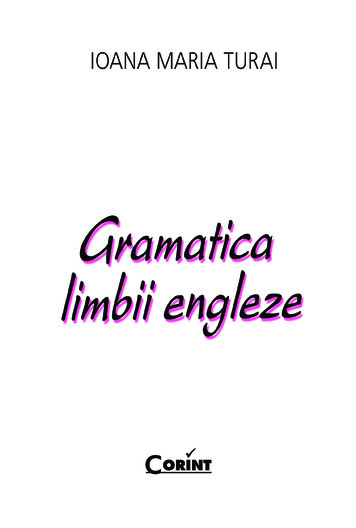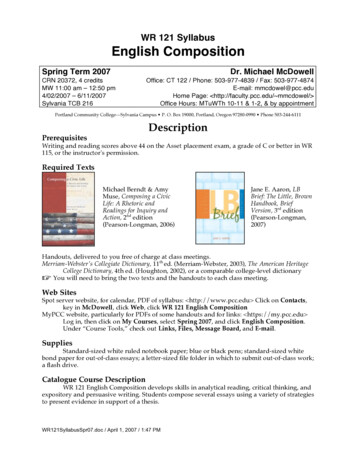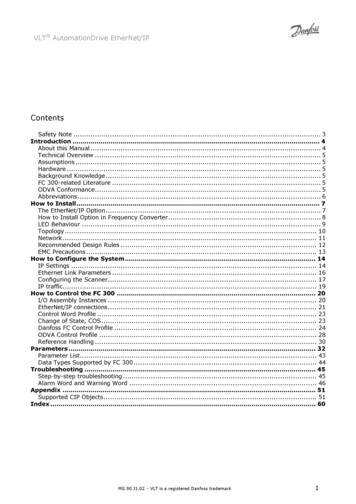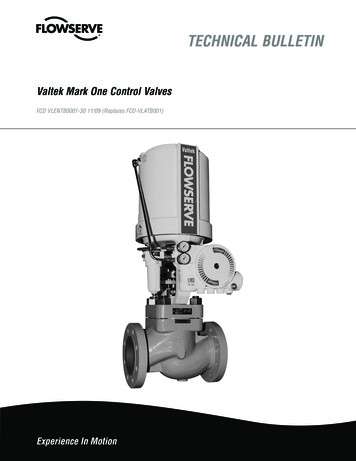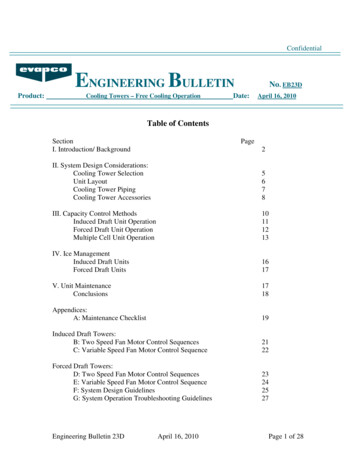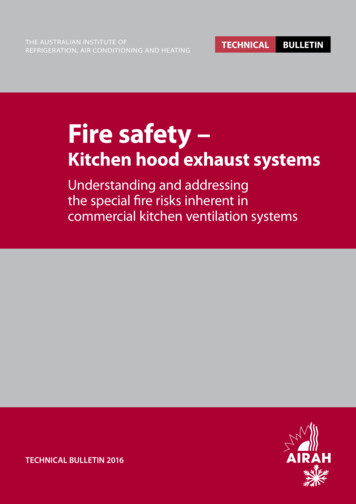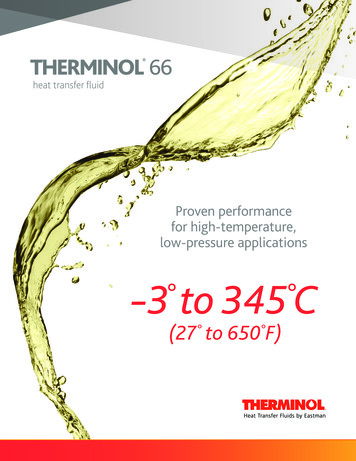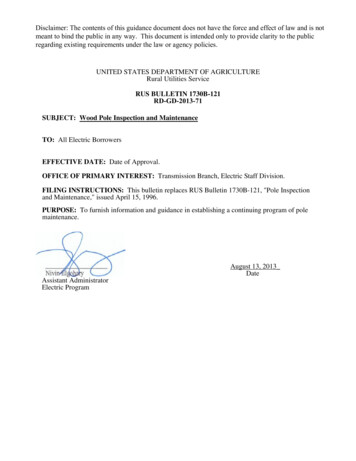
Transcription
Disclaimer: The contents of this guidance document does not have the force and effect of law and is notmeant to bind the public in any way. This document is intended only to provide clarity to the publicregarding existing requirements under the law or agency policies.UNITED STATES DEPARTMENT OF AGRICULTURERural Utilities ServiceRUS BULLETIN 1730B-121RD-GD-2013-71SUBJECT: Wood Pole Inspection and MaintenanceTO: All Electric BorrowersEFFECTIVE DATE: Date of Approval.OFFICE OF PRIMARY INTEREST: Transmission Branch, Electric Staff Division.FILING INSTRUCTIONS: This bulletin replaces RUS Bulletin 1730B-121, "Pole Inspectionand Maintenance," issued April 15, 1996.PURPOSE: To furnish information and guidance in establishing a continuing program of polemaintenance.August 13, 2013DateAssistant AdministratorElectric Program
RUS Bulletin 1730B-121Page 2TABLE OF CONTENTSPage12345678PURPOSE . 3GENERAL DISCUSSION OF POLE DECAY . 3PLANNED INSPECTION AND MAINTENANCE PROGRAM . 6INSPECTION METHODS .8ADDITIONAL INSPECTION TOOLS AND METHODS .9RESULTS OF WOOD POLE INSPECTION .10REMEDIAL TREATMENT.11DETERMINING THE SERVICEABILITY OF DECAYED POLES .14ExhibitsExhibit A: Metric Conversion FactorsABBREVIATIONSACA - Ammoniacal copper arsenateACZA - Ammoniacal copper zinc arsenateANSI - American National Standards InstituteAWPA - American Wood Protection AssociationCCA - Chromated copper arsenateEPA - Environmental Protection AgencyNaMDC - N-methyldithiocarbamateNESC - National Electrical Safety CodeMITC - Methylisothiocyanatepcf- pounds per cubic footRUS - Rural Utilities Service
RUS Bulletin 1730B-121Page 31PURPOSETo furnish information and guidance to electric cooperatives in establishing a continuingprogram of pole maintenance and to operating personnel in performing inspection andmaintenance of standing poles. Included in this bulletin are methods and procedures fordetermining the minimum permissible groundline circumferences of distribution andtransmission poles.2GENERAL DISCUSSION OF POLE DECAYPole Decay. Decay of treated poles is usually a gradual deterioration caused by fungi andother low forms of plant life. Damage by insect attack (termites, ants and wood borers) isusually considered jointly with decay because preservative treatment of wood protectsagainst both fungi and insects. In most cases, the decay of creosote and penta-treatedpoles will be just below the groundline where the conditions of moisture, temperature andair are most favorable for growth of the fungi. Factors affecting pole life, such as speciesof wood, type and thoroughness of treatment, geographical location, and soil conditionsare discussed below.aPole Species. Of the millions of poles on RUS financed systems, about 85percent are the thick sapwood southern pines. Untreated, the sapwood isespecially vulnerable to attack by wood destroying fungi, termites, and carpenterants. In the Gulf States, where temperature and moisture are most favorable forgrowth of these major wood-destroying organisms, the time to pole failure of anuntreated pole would be 2 to 3 years. In areas of lower rainfall and few frost-freedays, the time to pole failure would increase to 5 to 10 years.The bulk of the remaining pole population is classified as the western species,comprised of Douglas-fir, western red cedar, red pine, lodgepole pine, ponderosapine and a small amount of jack pine.Adequate preservative treatment protects the pole sapwood and the underlyingheartwood. Heartwood of these pole species varies not only in decay resistance,but is difficult to treat with preservatives. The heartwood decay resistance for themajor pole species is as follows:Durable - Western red cedar heartwood.Moderately Durable - Douglas-fir and most of the pines.Least Durable - Lodgepole pine. (The use of this species has been limitedprimarily to the Mountain States areas.)bPreservative Treatments. There are two general classes of preservative treatment,oilborne (creosote, penta in petroleum, and Copper Naphthenate) and waterborne(arsenates of copper). Creosote was the only preservative for poles on rural
RUS Bulletin 1730B-121Page 4systems until 1947, when post-war shortages prompted the introduction ofpentachlorophenol (penta) and Copper Naphthenate. Both of these preservativeswere dissolved in fuel oils from petroleum or mixtures with creosote.For many years, penta has been the most widely used preservative for poles. Withthe increase in cost of petroleum-based products, penta-in-oil treated pole costshave also increased. Presently, both penta and waterborne preservatives arewidely used with both preservatives having performed satisfactorily. Whereproblems have occurred with penta treated poles, the decay can be tied to poorconditioning of the poles, to the loss of solvent carrier due to migration andbleeding or to loss of dissolved penta to retentions below the effectivepreservative threshold. To overcome these losses, treatments and quality controlhave been improved.Standard wood preservatives used in waterborne solutions include ammoniacalcopper zinc arsenate (ACZA), and chromated copper arsenate (CCA) (types A, B,and C). These preservatives are often employed when cleanliness and paintabilityof the treated wood are required. Several formulations involving combinations ofcopper, chromium, and arsenic have shown high resistance to leaching and verygood performance in service. Both ACZA and CCA are included in manyproduct specifications for materials such as building foundations, building poles,utility poles, marine piles, and piles for land and fresh water use. Treatmentusually takes place at ambient temperature. Care needs to be taken duringtreatment to ensure heat sterilization of the pole when treating Douglas-fir withACZA.cDecay Zones. The following Decay Severity Zones on a map of the United Stateswas originally based on summer humidity and temperature information and lateron a pole performance study conducted by RUS. Decay severity ranges fromleast severe in Zone 1 to most severe in Zone 5. Service life records andindividual experience or a planned sample inspection will indicate if the decayhazard for a system is typical of the zone in which the system is located.
RUS Bulletin 1730B-121Page 5Decay severity zones for wood utility poles as defined by the USDA Rural UtilitiesService. Decay is least severe in zone 1, most severe in zone 5.dTypes of Decay. Internal decay may be found in southern pine poles that werenot properly conditioned or in which penetration or the amount (retention) ofpreservative is inadequate. Internal decay of the western species usually involvesthe heartwood in butt-treated western red cedar, lodgepole pine, and Douglas-firwhich have been improperly seasoned prior to treatment. After installation, decayorganisms invade the heartwood through the poorly treated sapwood zone checks,or woodpecker holes. Internal decay may also occur in field framed poles whensupplementary treatment is neglected.Insufficient treatment or migration of oil-type preservatives is the principal causeof external decay in southern pine poles. This decay is generally the result ofimproper seasoning or treatment. Inspection methods should be directed towarddiscovery of this type of defect and maintenance efforts to supplement thetreatment with additional chemicals.External decay above ground, or better known as "shellrot", may occur in butttreated western red cedars after 12-15 years of service.
RUS Bulletin 1730B-121Page 63PLANNED INSPECTION AND MAINTENANCE PROGRAMPurpose. The purpose of a planned inspection program is to reveal danger poles andpoles which are in early stages of decay so that corrective action can be taken to prolongthe service life of the pole. The end result of the inspection program is the establishmentof a continuing maintenance program for extending the average service life of all poleson the system. The steps in developing a planned pole inspection and maintenanceprogram are outlined below.aSpot Checking. Spot checking is the initial step in developing a planned poleinspection and maintenance program. Spot checking is a method of samplingrepresentative groups of poles on a system to determine the extent of pole decayand to establish the priority for a pole maintenance program. A generalrecommendation is to inspect a 1,000 pole sample made up of continuous poleline groupings of 50 or 100 poles in several areas of the system. The sampleshould be representative of the poles in place. For instance, all the poles on a lineor a map section should be inspected as a unit and not just the poles of a certainage group. The inspection of the sample should be complete, consisting ofhammer sounding, boring, and excavation as described in Section 4. Field datashould be collected on the sample as to age, supplier, extent of decay, etc.After the data has been collected, it should be analyzed to determine the areashaving the most severe decay conditions and to establish priorities of a pole-bypole inspection of the entire system. It may be desirable to take additionalsamples on other portions or areas of the system to determine if the severity ofdecay is significantly different to warrant the establishment of an accelerated poleinspection and maintenance program for that portion of the system. The results ofthe spot check will aid in scheduling a continuous pole inspection andmaintenance program at a rate commensurate with the incidence of decay.bScheduling the Inspection and Maintenance Program. The results of the spotcheck will aid in determining when the planned program should be started. Thesuggested timing for initial pole-by-pole inspection and subsequent re-inspection,when supplementary treatment is applied after each inspection, is as follows:Decay ZoneInitial InspectionSubsequentRe-inspection12 and 34 and 512 – 15 Years10 – 12 Years8 - 10 Years12 Years10 Years8 YearsPercent ofTotal PolesInspected Each Year8.31012.5The vulnerability of poles to decay is generally proportionate to the decay zone inwhich they are located. As a general recommendation, the initial pole-by-poleinspection program should be inaugurated at a yearly rate of 10 percent of thepoles on the entire system when the average age of the poles reaches 10 years. If
RUS Bulletin 1730B-121Page 7a spot check indicates that decay is advanced in 1 percent of the pole sample, theinspection and maintenance program should be accelerated so that a higherpercentage of poles are inspected and treated sooner than the figures shownabove. If the decay rate is low for a particular decay zone or area of the system,the pole-by-pole inspection can be postponed accordingly. Historical inspectiondata indicates that the ratio between the decaying/serviceable poles to reject polesin the 10-15 year age group is about six or more to one. In a 30-year age group, itis about one to one or less. In the latter group, the survivors have more thansufficient residual preservative to protect them indefinitely. The poorly treatedpoles in the 30-year old group have already decayed and been replaced.The greatest economic benefit from regular inspection is in locating thedecaying/serviceable group. Treatment of poles in this group can extend pole life,thereby saving the cost of emergency replacement. Inspection and propermaintenance can more than pay dividends by extending the serviceable life of thepoles. With the costs of replacing poles rising, the economics of extending theservice life are more favorable.cEstablishing the Program. The pole-by-pole inspection and maintenance workmay be done by system employees or by contracting with an organizationspecializing in this type of work. The choice should be made on the basis of theamount of work to be done, the trained employees available, and a comparison ofthe costs. Developing the necessary skills in the system's own crews may requireconsiderable time and be contingent upon the availability of an experiencedinspector to train system employees. Therefore, qualified contract crews may bepreferable for this work in many instances. An inspector to be qualified shouldhave inspected, as a minimum, 5,000 poles in conjunction with a qualifiedinspector and another 5,000 on his own, but under close supervision. Theinspector's work should be checked every week or two by the system'srepresentative and the inspector's supervisor. To check an inspector’s workselect at random about 10 poles, inspected in the previous few weeks, re-excavate,take off paper and treatment, and re-inspect. Check for hollow sounds, take aboring, check soft surface wood, especially adjacent to shaved areas or alongchecks, re-measure the pole, recheck the calculations, then retreat and backfill. Ifany serious errors are discovered, all the work between these spot checks shouldbe re-inspected.The pole inspection and maintenance program may result in a large number ofreplacements. If the reject rate is high, the system's crews may not be able toreplace rejected poles in a reasonable time because of other work. The temporaryaddition of skilled personnel for inspection or pole replacement may be required.It is generally necessary to use at least one crew full time to keep up with the poleinspector. An average pole inspector can check 150-200 poles per week or 800poles per month. It is desirable to have one person responsible for supervisionand coordination.
RUS Bulletin 1730B-121Page 8d4Re-inspections. Information obtained during the first pole-by-pole inspection canserve as the basis for scheduling subsequent inspections. As a guide, it isrecommended that a re-inspection be made every 8 to 12 years as shown inparagraph 3c of this Section, according to the decay zone and severity of decay.The recommended re-inspection intervals are based on treating poles during theprevious inspection cycle. Shorter re-inspection intervals are recommended ifpoles were not treated. These recommendations may be modified by experience,but the intervals should not be extended by more than 3 years. It is advisable torecheck some poles which have been groundline treated. At the completion of theinspection of a pole, a small, weatherproof tag should be attached to the poleindicating the organization that performed the inspection and the date of theinspection.INSPECTION METHODSInspection Types. There are varying types of inspection, each with a different level ofaccuracy and cost. Inspection methods with low accuracy require more frequent reinspection than methods which are detailed and more accurate.aVisual Inspection. Visual inspection should be considered the first step toinspecting poles but has the lowest accuracy. Since most decay is underground orinternal, this method will not detect the majority of defective poles. Obvious datacan be collected on each specific structure, such as the condition of the pole aboveground, crossarm, and hardware. This method is not recommended for detectingdecay.bSound and Bore. This method involves striking a pole with a hammer fromgroundline to as high as the inspector can reach and detecting voids by the hollowsound. An experienced inspector can obtain significant information about a poleby listening to the sounds and noticing the feel of the hammer. The hammerrebounds more from a solid pole than when hitting a section that has an internaldecay pocket. The internal pocket also causes a sound that is dull compared to thecrisp sound of a solid pole section.Some contracts require all poles to be bored, while others require boring onlywhen decay is suspected. Boring is usually done with either an incremental boreror power drill with a 3/8" bit. An experienced inspector will notice a change inresistance against the drill when it contacts decayed wood. The shavings or theborings can be examined to determine the condition of the wood, and the boringscan be analyzed for preservative penetration and retention.When voids are discovered a shell thickness indicator can be used to measurethem. This information can be used to evaluate the reduction strength by the void.The effectiveness of the sound and bore method varies by species. For southernyellow pine poles, which represent a majority of the poles in North America,
RUS Bulletin 1730B-121Page 9decay normally is established first on the outside shell below ground. The decaymoves inward and then upward to sections above ground. By the time sound andbore inspection can detect internal decay pockets above ground, the pole is likelyto have extensive deterioration below ground.Sound and bore method is more effective with Douglas-fir and western red cedar.Decay on these poles is likely to begin internally near the groundline, or in thecase of Douglas-fir, above the groundline. Therefore, sounding and boring canidentify at least some decay at a stage before the groundline section is severelydamaged. All borings should be plugged with a treated wood plug which isproperly sized for the respective hole.cExcavation. The effectiveness of the sound and bore inspection is greatlyincreased when excavation is added to the process. Excavation exposes the mostsusceptible section of the pole for inspection. For southern yellow pine this isparticularly true, since decay begins externally and below ground.Poles should be excavated to a depth of 18 inches in most locations. Deepexcavation may be required in dry climates. After excavation the exposed polesurface should be scraped clean to detect early surface decay.Shell rot and external decay pockets should be removed from the pole using aspecially designed chipper. Axes or hatchets should not be used for thisapplication. The remaining pole should be measured to determine if the pole hassufficient strength with the reduced circumference. Tables 2, 3, and 4 assist inadjusting circumferences for various size voids.After complete inspection and application of preservative treatment, the pole isbackfilled. The dirt should be tamped firm every 6 to 8 inches. The backfillshould mound up around the pole to allow for future settling and drainage awayfrom the pole.5ADDITIONAL INSPECTION TOOLS AND METHODSAdditional Methods. Over the past several years there has been a considerable amount ofresearch work done by companies to develop additional products that can be incorporatedinto the in-line pole inspection process. These products, involving many diversetechnologies, are intended to improve both the accuracy and reliability of the in-lineinspection programs used by utilities, as well as decrease the time necessary to carry outthe inspection process. In developing comprehensive inspection programs, cooperativesare encouraged to examine all potential inspection tools and processes to determine thebest system for their particular needs. The data from these testing devices does notalways correlate exactly with the actual bending strength determined by full scale testingand, as a result, should be used to establish trends showing changes in strength.
RUS Bulletin 1730B-121Page 106RESULTS OF WOOD POLE INSPECTIONaInspection Results. Inspection results should be used to update pole plant records,evaluate pole condition, plan future inspection and maintenance programs, andprovide information for map revisions. The inspection process will result inidentifying the condition of each individual distribution or transmission pole.In general the National Electric Safety Code (N
Disclaimer: The contents of this guidance document does not have the force and effect of law and is not meant to bind the public in any way. This document is intended only to provide clarity to the public regarding existing requirements under the law or agency policies. RUS Bulletin 1730B-121
